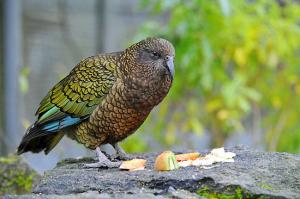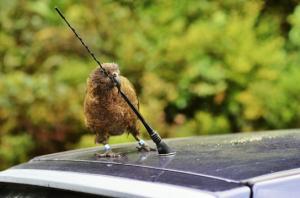There‘s something unique about New Zealand‘s native birds and it has to do with New Zealand‘s geological past.
 The Cheeky Kea
The Cheeky Kea
Back in the days of Gondwanaland, New Zealand separated from the mainland long before marsupials and mammals appeared. Existing in geographical isolation for millions of years, many of New Zealand’s birds never developed the ability to fly because they never had a need to escape predators.
The unique flightless birds (and many more with limited flight) are the reason so many visitors explore the stunning bush of Westland National Park and the Southern Alps. The most famous of all of New Zealand’s flightless birds is, of course, the rare Kiwi.
Before the introduction of predatory pests like deer, ferrets, and stoats, the animals of South Westland lived safely on the ground. Today, many of the region’s native birds are on the endangered list, making the World Heritage listing that Westland National Park enjoys vitally important.
The Cheeky Kea
One of the West Coast’s protected birds, and one of the most colourful local characters you’re likely to meet on your travels in and around Franz Josef Glacier, is the Kea.
Known as the ‘Clown of the mountain‘, the Kea is a mountain parrot that’s native to New Zealand and touted as one of the most intelligent birds on the planet. They’re cheeky characters that are well known for being mischievous, inquisitive and intelligent.
It’s believed Kea have been around for 5 million years. They are endemic to the alpine region of the South Island of New Zealand and are perfectly evolved for life in this chilly alpine setting. Their relatives are the Kaka, a forest parrot and the rare Kakapo, a flightless parrot who lives in the forests of low alpine zones. In the past Kea were hunted by Maori and also in the more recent past by farmers who believed they killed sheep and lambs.
 Kea’s are known to peck at all things shiny!
Kea’s are known to peck at all things shiny!
They have beautiful olive green plumage and stunning orange feathers on the underside of their wings. The Kea is famous (and infamous) for its inquisitive, confident nature and are known for having a fondness for eating the rubber lining of car doors and chewing on antennas. They are known to vandalise cars and campervans and steal lunch from unsuspecting trampers.
The story goes that in a brazen ambush, a Kea stole a Scottish tourist’s passport at a rest stop while he was travelling to Milford Sound. The Kea flew off with the passport, never to be seen again.
Like many native birds the Kea’s habitat is under threat from introduced pests. After European settlers first arrived in Westland, they were unimpressed with the lack of large land mammals. The calamitous decision was made to introduce deer & chamois for recreational hunting.
These animals, along with the inevitable rabbits and stoats have been the cause of the loss of native bush and native birds. Today, the Kea’s numbers are thought to be between 1,000 and 5,000.
The Kea is one of the South Island’s great personalities – keep an eye out while you’re around Franz Josef Glacier and you may just meet this cheeky local character.



